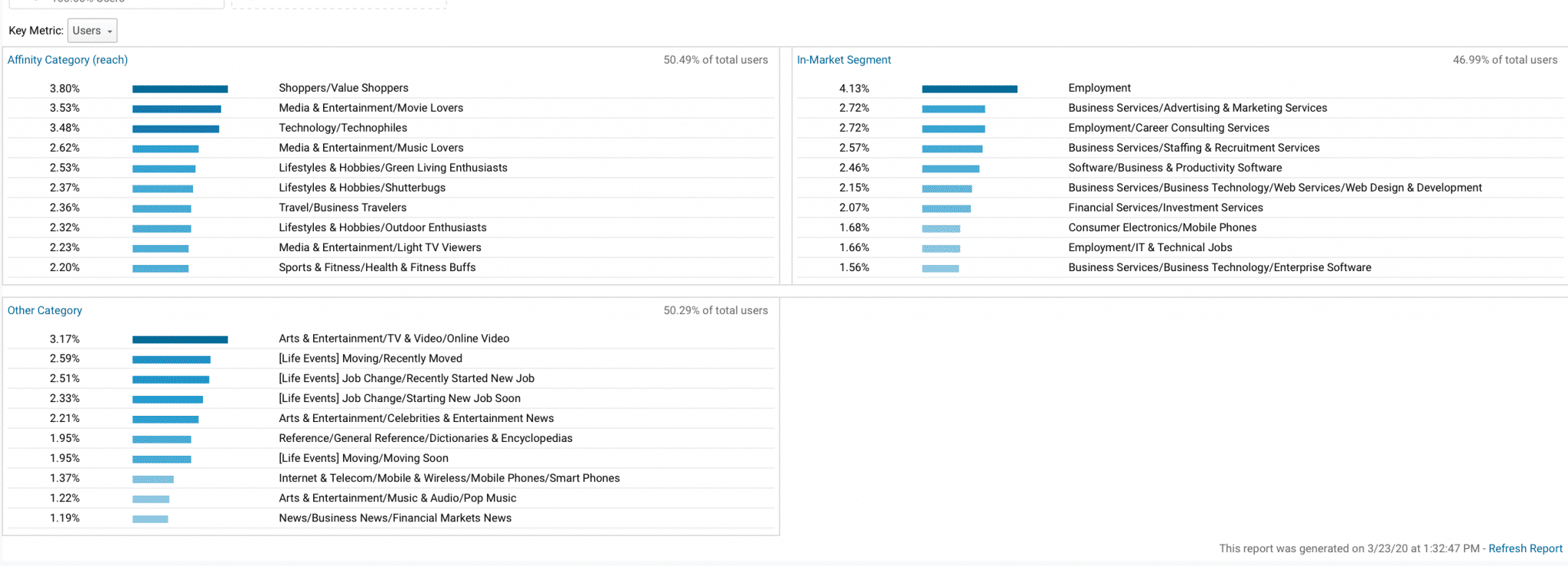What are Enhanced Ecommerce Analytics and Why Should You Use Them?
by Samantha Rugg • April 3, 2020
Here at Disruptive Advertising, we’re a data-driven agency. This means that we strategically center the campaigns we’re creating for clients around tried-and-true methods that we know are most likely to be effective.
Data is everything when it comes to increasing the likelihood of success—which is essential since no one wants to waste ad spend on campaigns that never had a shot in the first place.
We’re big believers in detailed, accurate analytics because of this. Industry benchmarks are useful, after all, but they aren’t enough on their own. Just because the average CTR rate in your industry is 0.5%, that doesn’t mean that’s automatically where yours should be. You need to know how your specific campaigns are impacting your individual business and understand who your audience is.
Stepping up your analytics game with Enhanced Ecommerce analytics is the way go, giving you an unparalleled look at how your campaigns are influencing sales and how you can optimize them further. In this post, we’re going to look at enhanced eCommerce analytics and why you should be using them.
What are Enhanced Ecommerce Analytics?
Google Analytics as it stands is a pretty outstanding tool for ecommerce businesses. You can see which platforms send you the most high-value traffic, track what encourages users to convert, and look for pages on your site that increase or decrease conversions.
This is excellent, but the ability to take these analytics a step further with Google’s Enhanced Ecommerce setup is a game-changer.
Enhanced Ecommerce allows you to measure user interactions with specific products on ecommerce sites throughout the user’s experience. This includes product clicks, impressions, viewing of product details, adding a product to a cart, initiating checkout, purchases, and requested refunds. You can see what information people are using to make their purchasing decision, what alternative products they may consider, and track overall success with finalized sales.
Many ecommerce platforms like Shopify make it very easy to set up Enhanced Ecommerce. They either set everything up for you natively or have easy-to-use plugins you can add.
If those options don’t work for you, you’ll need to add specific snippets of code to each relevant page that you want to track. If you want to track a user’s journey through the checkout process, for example, you need to add the tracking pixel to each individual page involved in the checkout process.

You can learn more about how to set up Enhanced Ecommerce and track results with it here. For now, let’s take a closer look at why exactly you should be using it.
1. It Makes Google Analytics Work for You
Google Analytics is an outstanding platform, telling you about the people visiting your site. You can see age, gender, geographic location, and their general shopping interests. This is inherently valuable for businesses because you can use it to understand who is coming to your site and shape buyer personas both for the users you’re currently attracting and the ones you want to attract in the future.

This information, however, only goes so far. If you can’t tell who exactly is purchasing, you’ll struggle to properly adapt and optimize your campaigns.
If 70% of the visitors heading to your site are male, for example, but only 5% of users who converted are male, there’s a good chance that your site is missing your target demographics. Without the plugin, however, you’d never be able to know this information from analytics on its own, and you may mistakenly but understandably assume that roughly 70% of your purchasing customers are male, too.
Information is only useful when it’s accurate, and the Enhanced Ecommerce plugin will ensure that you’re getting the full picture so that you’re acting on correct data.
2. The Data Possibilities are Almost Endless
With Google’s Enhanced Ecommerce plugin, you can see the overall performance of your site more clearly. Analyze data detailing the revenue, transactions, conversion rate, and bounce rate of different pages and products.
The key here is that you’re able to see product-specific data. See how many people add each specific product to their cart, and how many actually follow through. Keep in mind that abandoned cart rates are estimated to be somewhere between 55-85% across the board, depending on the business and industry.
You want to see if a lot of people are adding products but not converting, or if one of your product pages has an unusually high bounce rate. As you’re narrowing down where the interruption in the sales process occurs, you can isolate the issue and test different solutions to resolve it.
This also allows you to measure the performance of specific promotions that you’re using. See how many people are using the promotion code, what products they’re using on and if they successfully convert and make it all the way through the checkout process.
3. It Allows You to Analyze Your Customer Journey
Understanding the customer journey that your clients go through will help you optimize your site like never before.
Enhanced Ecommerce allows you to accurately gather data on the customers who have actually purchased. This is useful in itself, but the ability to more accurately track the customer journey is an incredible opportunity.
Let’s look at an example.
A potential customer is named Joe, and he’s looking for a new pair of shoes. That’s great! You sell men’s dress shoes.
Joe heads over to Google, and searches “brown leather dress shoes.” You just so happen to have Google Shopping ads running, and he clicks on an ad all the way through to your site.
Joe isn’t quite ready to purchase yet, so he browses, looking at a few more pairs of shoes.
Several days later, your retargeting campaign on Facebook Ads shows up in his feed, encouraging him to go back and check the shoes out again. He adds the product to his cart, but then something happens and he doesn’t actually purchase.
You’re not giving up though. The next day, your abandoned cart email pops up in his inbox. He clicks through and finally converts.
Without Enhanced Ecommerce, you wouldn’t be able to accurately track this journey. Instead, depending on the attribution model you’ve chosen, you may only end up seeing that Facebook helped with this conversion, or only Google Shopping or only an email. In reality, that customer wouldn’t have become a customer without every single step of the process.
As you can see which marketing efforts are effective at pushing users through the sales funnel, you’ll be able to optimize not only your site, but your off-site ad campaigns, too. You’ll be able to more effectively connect with your target audience and drive more sales as a result.
Final Thoughts
Information is really only valuable if you have enough of the details for it to actually become actionable. Knowing that 70% of your site visitors are male, for example, only tells you that your marketing efforts are successfully attracting a largely male audience, not that they’re actually converting or why that may or may not be.
Ecommerce businesses often have complex customer journeys, and the ability to track what’s happening online can help you better understand what does and doesn’t appeal to your audience, and what objections or struggles they may have when deciding to purchase. When used correctly, this information can help you shape your site and every campaign you’re using to drive consumers there to purchase, including the specific promotions you offer.
Looking for assistance in optimizing your campaigns and interpreting the data you’re getting from Google’s Enhanced Ecommerce analytics? Contact us to see how we can help.
What do you think? Do you use Google’s Enhanced Ecommerce analytics on your site? How do use the data there to optimize your site and your campaigns? Share your thoughts and questions in the comments below!





